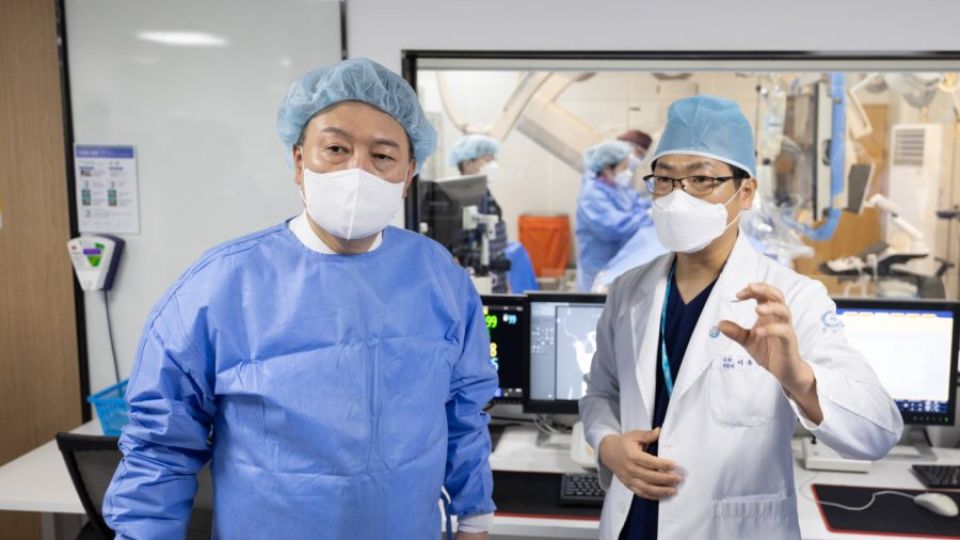March 27, 2024
SEOUL – President Yoon Suk Yeol on Tuesday reiterated his stance that the medical school expansion plan is a prerequisite for improving the quality of care at regional hospitals.
At a Cabinet meeting held in his office Tuesday, Yoon said the plan to increase the school quota by 2,000 to 5,058 starting 2025 — confirmed on March 20 — is “a minimum requirement” to address the doctor shortage and improve the medical system, especially in remote areas.
Under the plan, the students admitted to school in 2025 will be eligible to work at a hospital six years later.
“The government will use the medical school quota hike as a chance to establish competent regional hospitals,” Yoon said.
“I’ve repeatedly stressed that strong medical and educational (infrastructure) will lay the basis for the livability of those living in remote areas, thereby enabling rebalancing of the national economic growth. … The equity gap in terms of access to basic social services shall be removed to make the country sustainable.”
Secondary general hospitals will also be created in regional areas so they can provide essential health care, and these general hospitals will establish coordination with tertiary general university hospitals, according to Yoon.
Yoon also promised to provide more support for trainee doctors who received training at regional university hospitals in seeking a job in the region they studied. Moreover, medical schools in non-urban regions will give those who finished their secondary education there a greater chance of admission, by allocating a 60 percent quota, up from the current 40 percent.
“Those graduating from medical schools in regional areas are likely to get employed in non-metropolitan regions,” Yoon said. He added that research and statistics prove it, but he did not elaborate on the details.
“We will create an environment in which those who graduated from regional medical universities would not have to come to medical schools in metropolitan areas to continue their medical training.”
In this regard, Yoon asked medical professors to sit down for talks with the government and to persuade the trainee doctors to stop pursuing their resignations from their jobs.
Later at 2 p.m. Prime Minister Han Duck-soo held a follow-up meeting with representatives of university hospitals and deans of universities that operate hospitals, after one in mid-March, to discuss ways to cope with the fallout of the doctors’ walkout that the university hospitals had suffered.
This came as medical professors on Monday began to resign from their workplace to protest the government’s move to increase the number of doctors in the country.
Protests from the medical circles show no signs of abating.
About 9,600 trainee doctors, or about three-quarters of them nationwide, offered resignations from their workplace, while the government ordered the university hospitals to refuse to accept them. Also, 9,230 medical students in Korea, or half of the students nationwide, applied to take an academic break, according to the government’s estimate.
Regardless, Yoon said the follow-up measures to the confirmed school quota increase are now underway, indicating there will be no backtracking in his pursuit of the 2,000 hike plan.
Yoon vowed to support hospitals suffering a shortage of facilities or equipment, in response to the university hospitals’ demand in line with the increase in the number of students.
“(The government) will adequately support the necessary facilities and equipment,” said Yoon. “We have three years ahead for preparation before the students admitted to medical school in 2025 get medical training (at teaching hospitals) in 2027.”
This resonated with the government’s announcement, which indicated it would wrap up the follow-up measures for allocating 2,000 new places at medical schools across the country by May, piling pressure on protesting doctors.
“The government will continue to do its best to provide stable medical education support by collaborating closely with relevant ministries and each medical school,” Second Vice Health Minister Park Min-soo said during the press briefing Tuesday.
A task force dedicated to supporting medical education under the Office for Government Policy Coordination held a meeting at 5 p.m. Tuesday to discuss plans to hold demand surveys for medical schools, asking them what needs to be done to improve educational quality, according to Park.
In addition, officials at the Education Ministry will visit each medical school from Tuesday to Friday to collect opinions about ways to improve learning conditions to accommodate more students, Park added.
President Yoon said the plans to support medical schools in response to the school enrollment hike will be finalized in April based on the demand surveys.
Yoon’s approval rating, on the other hand, has been constantly declining, after having an upsurge in late February when he unveiled the plan to increase medical school quotas.
According to a poll by Realmeter announced Monday, Yoon’s approval rating dipped 2.1 percentage points to 36.5 percent in the third week of March, declining for five straight weeks since his popularity reached 41.9 percent in the fourth week of February, topping the 40 percent-mark for the first time in eight months.


